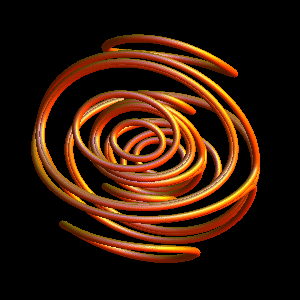This is a follow-up question to this one on visualizing vector-spherical harmonics. This time, I would like to visualize the vector spherical waves (including the radial dependence). The functions that I would like to plot, VectorSphericalWaveE[J, M, kr, θ, ϕ] and VectorSphericalWaveM[J, M, kr, θ, ϕ] are defined below. Please note there was a typo in ϵ[λ_], in the linked question, which I have corrected.
Clear[ϵ]; (*Polarization vector*)
ϵ[λ_] = Switch[λ,
-1, {1, -I, 0}/Sqrt[2],
0, {0, 0, 1},
1, -{1, I, 0}/Sqrt[2] ];
Clear[VectorSphericalHarmonicV];
VectorSphericalHarmonicV[ℓ_, J_, M_, θ_, ϕ_] /;
J >= 0 && ℓ >= 0 && Abs[J - ℓ] <= 1 && Abs[M] <= J :=
Sum[
If[Abs[M - λ] <= ℓ, ClebschGordan[{ℓ, M - λ}, {1, λ}, {J, M}], 0]*
SphericalHarmonicY[ℓ, M - λ, θ, ϕ]*ϵ[λ], {λ, -1, 1} ]
Clear[RadialR, VectorSphericalWaveE,VectorSphericalWaveM];
RadialR[kr_, ℓ_] = I^ℓ SphericalBesselJ[ℓ, kr];
VectorSphericalWaveE[J_, M_, kr_, θ_, ϕ_] /; J >= 0 && Abs[M] <= J :=
If[J > 0, -Sqrt[((J + 1)/(2 J + 1))] SphericalBesselJ[J - 1, kr] VectorSphericalHarmonicV[J - 1, J, M, θ, ϕ], 0]
+ Sqrt[J/(2 J + 1)] SphericalBesselJ[J + 1, kr] VectorSphericalHarmonicV[J + 1, J, M, θ, ϕ];
VectorSphericalWaveM[J_, M_, kr_, θ_, ϕ_] /; J >= 0 && Abs[M] <= J :=
I SphericalBesselJ[J, kr] VectorSphericalHarmonicV[J, J,
M, θ, ϕ];
The functions VectorSphericalWaveE and VectorSphericalWaveM takes two integer arguments $J\geq 1$ and $-J\leq M \leq J$, and three continuous arguments: the radial coordinate $kr>0$, and the angular coordinates $\theta$ and $\phi$. The output is a real vector.
Because these functions give out real-valued vectors, I would like to visualize them using vector plot.
I tried the following:
VectorPlot3D[
Re[VectorSphericalWaveM[2, 1,
Sequence @@ CoordinateTransform["Cartesian" -> "Spherical", {x, y, z}]]],
{x, -5, 5}, {y, -5, 5}, {z, -5, 5},
RegionFunction -> ((#1^2 + #2^2 + #3^2 <= 5^2) &)]
But got a crummy output (see below). I can hardly tell what's going on. I know these vector fields are supposed to be circulatory only, so it would be nice if that aspect can be emphasized in the plot. Also, is there a way to include some kind of distance fog, so that arrows in the back, are greyed out?


